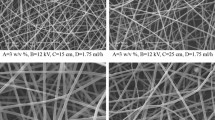Abstract
Electrospun nanofibres can be used in nanosensors, nanofilters, catalysts, tissue scaffolds, batteries, solar cells, protective clothing and so on. The major improvement in various applications is brought about by the enhanced surface area of the electrospun nanofibres. We employed a statistical approach to optimize electrospinning process parameters to produce cellulose acetate (CA) nanofibre mat with Brunauer–Emmett–Teller (BET) surface area as the response variable. The selected variables (applied voltage, distance between needle and collector, and flow rate of solution) were optimized by response surface methodology (Central Composite Design–CCD) to capture the linear and quadratic influence to maximize specific surface area (SSA) of electrospun fibre mat measured by BET analyzer. The predicted model was significant with R2 value of 0.91 and adjusted R2 value of 0.83. This model predicted the SSA of 2.34 m2 g−1 for the optimized parameters 24.8 kV voltage, 12 cm distance between needle and collector and 0.04 ml min−1 flow rate. The difference between the predicted value and the experimental result at the same parameters setting was less than 5%. The obtained results confirmed that the selected CCD model appropriately presented the performance of selected parameters in the prediction of SSA of CA nanofibre mat.







Similar content being viewed by others
References
Teo W E and Ramakrishna S 2006 Nanotechnology 17 R89
Huang Z M, Zhang Y Z, Kotaki M and Ramakrishna S 2003 Compos. Sci. Technol. 63 2223
Bhardwaj N and Kundu S C 2010 Biotechnol. Adv. 28 325
Deitzel J M, Kleinmeyer J, Harris D and BeckTan N C 2001 Polymer 42 261
Ki C S, Baek D H, Gang K D, Lee K H, Um I C and Park Y H 2005 Polymer 46 5094
Li D and Xia Y 2004 Adv. Mater. 16 1151
Yoon K, Hsiao B S and Chu B 2008 J. Mater. Chem. 18 5326
Won K S, Donghwan C and Won H P 2006 Nanotechnology 17 439
Luo C J, Stoyanov S D, Stride E, Pelan E and Edirisinghe M 2012 Chem. Soc. Rev. 41 4708
Baji A, Mai Y W, Wong S C, Abtahi M and Chen P 2010 Compos. Sci. Technol. 70 703
Casper C L, Stephens J S, Tassi N G, Chase D B and Rabolt J F 2004 Macromolecules 37 573
Zhang D and Chang J 2008 Nano Lett. 8 3283
Nasir M, Matsumoto H, Danno T, Minagawa M, Irisawa T, Shioya M et al 2006 J. Polym. Sci. Part B: Polym. Phys. 44 779
Yördem O S, Papila M and Menceloğlu Y Z 2008 Mater. Design 29 34
Megelski S, Stephens J S, Chase D B and Rabolt J F 2002 Macromolecules 35 8456
Ding B, Yamazaki M and Shiratori S 2005 Sens. Actuators B: Chem. 106 477
Ding B, Kim H Y, Lee S C, Shao C L, Lee D R, Park S J et al 2002 J. Polym. Sci. Part B: Polym. Phys. 40 1261
Ma M, Mao Y, Gupta M, Gleason K K and Rutledge G C 2005 Macromolecules 38 9742
Naderi N, Agend F, Faridi-Majidi R, Sharifi-Sanjani N and Madani M 2008 J. Nanosci. Nanotechnol. 8 2509
Konwarh R, Misra M, Mohanty A K and Karak N 2013 Carbohydr. Polym. 92 1100
Dalton P D, Vaquette C, Farrugia B L, Dargaville T R, Brown T D and Hutmacher D W 2013 Biomater. Sci. 1 171
Liu Y, Wang Q, Lu Y, Deng H and Zhou X 2020 Int. J. Biol. Macromol. 152 672
Jia Y, Yu H, Zhang Y, Dong F and Li Z 2016 Colloid Surf. B Biointerfaces 148 263
Acknowledgements
We are thankful to Dr P G Patil and Dr Sujata Saxena of ICAR-CIRCOT, Mumbai, for guidance and technical support. We acknowledge the funding support from the Indian Council of Agricultural Research through National Agricultural Science Fund (Mn 4017).
Author information
Authors and Affiliations
Corresponding author
Supplementary Information
Below is the link to the electronic supplementary material.
Rights and permissions
About this article
Cite this article
Prabu, G.T.V., Guruprasad, R., Sundaramoorthy, C. et al. Process optimization and modelling the BET surface area of electrospun cellulose acetate nanofibres using response surface methodology. Bull Mater Sci 45, 133 (2022). https://doi.org/10.1007/s12034-022-02712-6
Received:
Accepted:
Published:
DOI: https://doi.org/10.1007/s12034-022-02712-6




